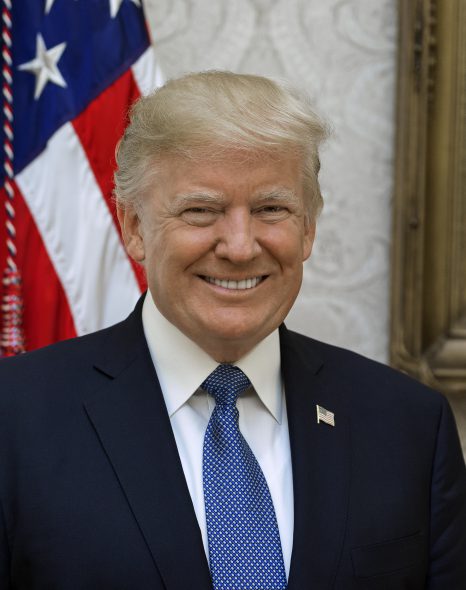Trump Tariffs Slam Wisconsin Economy
Bad for companies, workers, consumers — and probably for Trump's reelection chances.

Official portrait of President Donald J. Trump, Friday, October 6, 2017. Official White House photo by Shealah Craighead.
For decades ginseng had been a remarkable success story for Wisconsin, with more than 95 percent of U.S. ginseng exports made in Marathon County and sold to China, whose people have long prized ginseng for its heath benefits. Then President Donald Trump started a trade war with China and the Chinese retaliated, targeting states they knew he needed for reelection, states like Wisconsin. The Chinese added a tariff that increased the price for ginseng by 41 percent.
The skyrocketing tariffs “sent ginseng prices plunging from nearly $50 per pound of cultivated ginseng to closer to $20 per pound,” as Will Hsu, president of Hsu’s Ginseng Enterprises in Marathon County, told Wisconsin Public Radio. “That’s because U.S. growers have to essentially deduct the added cost of Chinese tariffs from their own prices,” the story noted.
Bob Kaldunski, president of the Ginseng Board of Wisconsin, told WSAW News in Wausau that two years of trade wars with China and unreliable weather has left the ginseng industry with a production cost that exceeds market prices. Workers are being laid off and recovery for the industry on the whole may not come earlier than 2021, Hsu predicted.
The devastation of the ginseng industry is just one example of how Trump’s tariff wars have hurt the Wisconsin economy. Unlike other Midwestern states, which had long had huge annual trade deficits, Wisconsin had been a clear global trade winner, as Urban Milwaukee has reported. Wisconsin had typically exported as much in an average year as it imported, varying between a small trade surplus (in 2013, the state had $23.1 billion in exports compared to $22.2 billion in imports) and small trade deficit (in 2015 Wisconsin has $22.4 billion in exports and $23.0 billion imports), the story noted.
By contrast, surrounding states in the Midwest had huge global trade deficits, led by Michigan (more than $70 billion) and Illinois (nearly $58 billion).
But then Trump started a trade war, which has been disastrous for Wisconsin, whose economy has heavily relied on trade with Canada, Mexico and China, its top trading partners in that order. In 2016, when Trump was elected, Wisconsin had a small trade deficit, of $1.4 billion, with $22.4 billion in imports and $21 billion in exports, according to annual information compiled by the U.S. Census Bureau.
That ballooned to a $5.4 billion deficit in 2017, $8.2 billion in 2018 and dropped a bit to $6.8 billion in 2019. The state’s total exports are down significantly over the last two years while its imports have risen significantly. And the decline in exports is driven by a 21 percent decrease in exports to China from 2017 to 2019 and a 33 percent decline in exports to Hong Kong over that period, the Census Bureau statistics show.
Ginseng is just one example of Wisconsin exports that have taken a big hit due to the Trump tariffs. China is the world’s largest importer of park products, which was great for Wisconsin producers, but there’s now a 72 percent tariff on pork sales in China, as Keri Retallick, executive vice president of the Wisconsin Pork Association, explained to Wisconsin Public Radio. And that has been killing pork exporters. Wisconsin is also the largest U.S. producer of cranberries, which saw a sharp decline in exports to China, the story noted.
An analysis by the group, Tariffs Hurt the Heartland found that Trump’s tariffs have cost Americans — businesses, farmers and consumers— $42 billion since the trade war began in February 2018 through October 2019. The cost for Wisconsin was $827 million.
And this was before the pandemic wreaked havoc on the national and global economies, as are all the figures on Wisconsin’s growing trade deficit.
The longer this relationship remains broken, the longer Wisconsin trade with China is suppressed, the more unlikely the partnership will return as before, because the Chinese will switch to more reliable trading partners. As University of Wisconsin-Madison political scientist Jon Pevehouse noted to Wisconsin Public Radio: “There have been instances where U.S. farmers have been the victim of, say, retaliatory tariffs, where then those tariffs get lifted, and the state, whether it’s Mexico, Germany, whoever, doesn’t go back to buying Wisconsin products.”
All of which is bad news for the Wisconsin economy. And bad news for the Trump campaign leading into a November election he is unlikely to win should he lose Wisconsin.
If you think stories like this are important, become a member of Urban Milwaukee and help support real, independent journalism. Plus you get some cool added benefits.
More about the Trump Tariffs
- Op Ed: Trump Tariffs Have Failed - John Torinus - Sep 27th, 2020
- Murphy’s Law: Trump Tariffs Slam Wisconsin Economy - Bruce Murphy - Jun 29th, 2020
- Baldwin Calling on Trump Administration to Take Action and Support Wisconsin Hardwood Businesses Hurt by Trade War - U.S. Sen. Tammy Baldwin - Feb 25th, 2020
- Trade War Wounds May Heal Soon - Erik Gunn - Feb 21st, 2020
- How China Trade Agreement Impacts Wisconsin Farmers - Miranda Suarez - Jan 16th, 2020
- Trump Tariffs Have Cost State $800 Million - Miranda Suarez - Dec 10th, 2019
- U.S. Senator Tammy Baldwin Seeks Investigation into Possible Market Manipulation Regarding Market Bets Timed to Trump’s Comments on Trade War & Other Geopolitical Events - U.S. Sen. Tammy Baldwin - Oct 21st, 2019
- Port Milwaukee Shipping Up in 2019 - Danielle Kaeding - Oct 21st, 2019
- Stuck to Gallagher: Does Your Party Care About Small Business? - State Rep. Amanda Stuck - Oct 10th, 2019
- Evers Blasts Trump “Tweet” Trade Wars - Erik Gunn - Sep 16th, 2019
Read more about Trump Tariffs here
Murphy's Law
-
National Media Discovers Mayor Johnson
 Jul 16th, 2024 by Bruce Murphy
Jul 16th, 2024 by Bruce Murphy
-
Milwaukee Arts Groups in Big Trouble
 Jul 10th, 2024 by Bruce Murphy
Jul 10th, 2024 by Bruce Murphy
-
The Plague of Rising Health Care Costs
 Jul 8th, 2024 by Bruce Murphy
Jul 8th, 2024 by Bruce Murphy





















Bruce,
You identified an especially sore spot with your focus on Trump’s tariffs adversely affecting the ginseng industry in Wisconsin.
,
The ginseng industry grew in central Wisconsin’s Marathon County when that county received a large # of Hmong immigrants from Laos and Cambodia in the late 1970’s and 80’s. Many Hmong soldiers fought with U.S.troops vs. Viet Cong in the war in Vietnam. When we withdrew from Vietnam, many of those allies were slaughtered by the victorious Viet Cong.
Large #s of Hmong people fled their homelands, lived in refugee camps in Thailand, and eventually found their way to the United States. Large #s of these refugees came to Milwaukee and to Marathon County. Those who went to Marathon County noted that conditions there were suitable to the growth of ginseng.
Marathon County Hmong made central Wisconsin famous for ginseng. Trump’s silly trade war with China has slapped down the Hmong people yet again. They had to live in refugee camps between fighting with us and earning our shores, They built their own ginseng industry here. Trump’s silly trade war with China is killing our Hmong’s ginseng industry.
Correction: ginseng farming and sales of that product in Marathon County took place before the Hmong migration to that county. It accelerated when Hmong moved there.